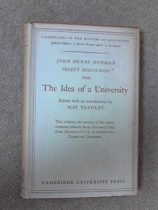Newman, J. H. (1931). Select Discourses from the Idea of a University. Cambridge, England: The University Press. Edited with an introduction by May Yardley.

This short book includes Discourses I, V-IX and “Literature: a Lecture” from Cardinal John Henry Newman’s seminal work: The idea of a university defined and illustrated I. In nine discourses delivered to the Catholics of Dublin II, including Discourses I, V-IX and “Literature: a Lecture”). The original lectures, delivered in 1852, were published as On the Nature and Scope of a University Education, later expanded as “the Idea of University” (the “ninth and definitive edition” was revised in 1889 and published in London and New York by Longmans, Green and Co.) The introduction by May Yardley warrants reading as a stand-alone essay and/or for historical background before reading Newman’s work in its entirety.
Nineteenth century Britain saw the opening of higher education to “the lower middle classes” as being “attractive, useful and productive of virtue” (p. vii), with the emphasis on “usefulness”. This drew criticism from traditionalists as “popularizing a superficial smattering of many subjects at the expense of real education” (viii); and claims that educating “the masses” meant “the sacrifice of education itself” (ix). So here we see the roots of the ongoing tension between “classical education” and “vocational training” as well as the beginning of the “battle between science and religion”.
Note the relationship to first two of Lonergan’s “challenges of education”: the masses and “the new education”.
Newman was not specifically opposed to “usefulness” or the education of the masses, but rather to the secularization of higher education (we might make a parallel with the contemporary “corporatization” of higher education). Ironically the initial aim of secular education was not to exclude religion, but to make universities open to all religions (in Ireland, specifically to both Catholics and Protestants). Newman was not opposed to this either, although many Catholic leaders, including the Pope [Pius IX] were, but he lamented the exclusion of theology and the breeding of “false liberalism” (x). Newman later stated that:
“A University is pledged to admit, without fear, without prejudice, without compromise, all comers, if they come in the name of truth” (Lecture on Christianity and Scientific Investigation, 1855, italics mine). This still is (or should be) a cornerstone of Catholic education.
Newman had “no fear of intellectual freedom … provided that as much liberty was allowed to religion as to science” (xi). Yardley’s account of Newman “the man” is permeated by his dedication to truth, encapsulated in his assertion that “Truth is wrought out by many minds working freely together” (xviii). His ideal of a university meant teaching “universal knowledge”, which includes theology – so the secular university that omitted theology left a critical gap in knowledge, making it impossible to know “the whole truth”. Newman asserted that “theology is science … a totality of revealed truths” (xx).
Of particular relevance today, Newman noted that education is not restricted to the classroom; students learn more from living and conversing with one another than in lectures, hence his insistence on residential colleges: “the greatest art the student has to learn is of living in and helping to form an intelligent society” (xxii). He saw education as the remedy for the “besetting sins” of prejudice and narrow mindedness” and the difference between “learning and knowledge”. He saw the real function of a university to be training “good members of society” (xxiv) which leads to “the humanizing of society” (xxv). To this end he was also opposed to “premature specialization” since exclusively studying one subject “deadens the mind” to other subjects.
Note Lonergan’s third “challenge to education”: specialization.
Yardley is gently critical of Newman’s lack of pragmatism (he says nothing of how his ideal of education is to be achieved), and his lack of a place for post-graduate research, especially in the sciences – how can the boundaries of knowledge be expanded without independent research? (xxvi). But her principle criticism is Newman’s assertion that the role of education is to train the intellect and to create “good citizens” who do no harm – which is essentially negative, and is that “goodness”? Newman believed that conscience, “goodness” or “holiness” does not come from education but only from religion, which is above reason (xxix). This seems somewhat contradictory (recall his insistence on theology and the equality of science and religion) but makes sense in the context that religion and faith are ultimately not taught, but based on an inner revelation between an individual and God*. He asserts that “as the university does not aim at making men learned or preparing them for a profession, so it cannot make men holy” (xxix).
Questions
How do Newman’s ideas resonate (or fall short) in the context of contemporary Catholic higher education?
- Education should be open to all who “seek truth” (what about the financial aspect?)
- Theology is an essential part of education.
- The primary role of education is to train the intellect, seek out truth and create good, “cultured” citizens (in Newman’s terminology of the day, “Gentlemen”)
- Education should be “residential” (promoting education beyond the classroom)
- Over-specialization is contrary to ideal education (can “inter-disciplinarity” address this?)
- Education cannot teach “holiness” (this is the role of religion), although developing the intellect, reason and truth-seeking promote goodness by overcoming prejudice and narrow-mindedness.
- If Newman’s “ideal” (in whole or part) is still relevant, how do we achieve it?